Which would you rather have? A 50% chance of winning $10 or a 100% chance of winning $5?
This kind of question can mean very different things depending on who you ask. Pure economists would say that the “expected value” of each option is identical. In the long run if you made the same choice over and over – no matter which choice it was – you’d net out with approximately $5 per iteration.
Naturally, things become convoluted when you introduce emotions and behavioral economists. They’ve done studies that reveal human tendencies to avoid risk and take the sure thing. On the other hand, there are also studies that indicate with small bets like five or ten dollars, people are more open to the risk than with gigantic bets like one hundred thousand dollars. I may be willing to risk $5 to win $10 more readily than I’d be willing to risk $50,000 to win $100,000.
But let’s put behavioral economics aside for a change, and focus on true expected value using pure economics. I believe I can apply this fundamental theory to an interesting situation in MTG Finance. Allow me to explain.
Real World Example
When trading stocks on Wall Street, the concept of expected outcomes is often used to evaluate a stock’s potential price. For example, analysts may evaluate the percent likelihood a small pharmaceutical company will have a successful phase three trial for their breakthrough drug, and then use that determination to estimate a stock price target. Through tireless research they determine a successful trial is 70% likely and would result in a $50 stock valuation while a 30% chance of failure would mean a $5 stock valuation. Doing the numbers, they’d therefore buy the stock if it’s below the expected value, 50*75% + 5*30% = $39, and sell if it exceeds this price.
Granted this is probably an oversimplification, but it illustrates the point. Recently I keep hearing that interest rates are pricing in a 70% chance of a federal reserve rate hike in December. To me, this means bonds are trading using a similar expected value calculation based on likelihoods.
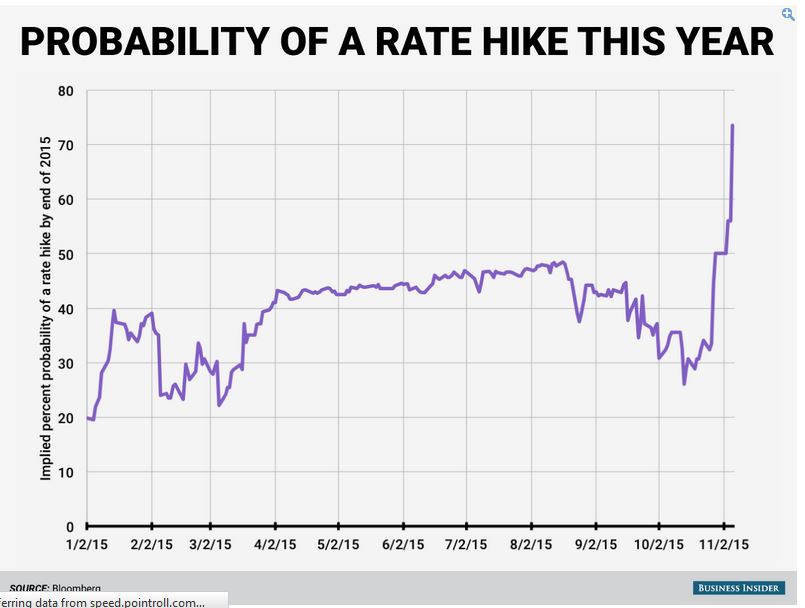
As an investor, I believe the chance of a rate hike in December is even higher, and I’m buying certain stocks accordingly. Financial companies tend to do better when rates are rising, for example. (Disclaimer: This is not investment advice, you should do your own research before making an investment decisions.)
From RL Finance to MTG Finance
I believe this concept of expected value can be reapplied to a very special group of cards in the MTG Finance world. I’m talking about Zendikar Fetch Lands.
When Battle for Zendikar was announced, the enemy colored Fetch Lands faced tremendous headwinds from a price appreciation standpoint. While many other Modern cards were rallying, it seemed the original Zendikar fetches were stagnant…and for good reason. After seeing Shock Lands get hammered by a reprint in Return to Ravnica, many players applied a high percent likelihood the same would happen to Zendikar. Then once the set was spoiled and there were no Zendikar fetches, prices spiked.
I’ll use Scalding Tarn as a case study as it’s the most expensive fetch today.
For ease of calculations, let’s assume that at its peak, Scalding Tarn was priced to have 0% likelihood of any pending reprint. We can then assume that the “right” price at maximum Modern hype for Scalding Tarn assuming no reprint is roughly $125. Of course, the card moved off that crazy high when Modern hype relaxed some. When hype subsided, players began pricing in a reprint in some set. If we assumed Scalding Tarn would drop to $20 if it was reprinted, we can back calculate and determine that the market was pricing in a 60% chance of a reprint in the near future at this time.
Then in March 2015, Wizards announced Battle for Zendikar. At that time, the value dropped from $60 to $50. This drop in price was likely related to adjustments to reprint expectations. Perhaps the chance of a fetch reprint went from 60% to 70% at that time, explaining the $10 price drop.
Then when Battle for Zendikar was fully spoiled and it became clear Zendikar fetches were safe, prices shot up dramatically again. Scalding Tarn peaked at around $100, indicating the chance for a reprint in some upcoming set (such as the new Commander decks) dropped all the way back down to 20%. Of course that hype didn’t last, and before long Scalding Tarn dropped back down to where it is today, at about $80. As of today my calculations dictate that the market is pricing in a 43% chance of a Scalding Tarn reprint in the near future.
The Opportunity
Here’s the thing: I believe the likelihood of a Zendikar fetch land reprint is much less than 43%. We just received the full set list of the Commander 2015 products and to few people’s surprise, there were no fetches included. I’ll admit I was momentarily frightened because of the enemy-colored nature of the decks. But after listening to rationale on Brainstorm Brewery, my fears were allayed significantly.
Without reprint in Commander decks, I question when the next possible opportunity is to see Zendikar fetches. They won’t be in Oath of the Gatewatch. I don’t think they really fit in with Shadows over Innistrad – after all, the return to Innistrad will be excitement enough to sell this set. Wizards won’t need to reprint fetches to help sell it because the horror theme is so beloved by players already.
If I had to place my bets, I’d say we won’t see a reprint of Zendikar Fetch Lands until the block after Shadows over Innistrad or in Modern Masters 2017. That’s a long ways away. I believe the percent likelihood of a Zendikar Fetch Land reprint should be more in the 10-20% range. Using my basic spreadsheet, that yields a price range of $104-$115 for Scalding Tarn – a hefty premium to where it is today!
Based on all of this data, I pose this bold prediction for open consideration: by the time Modern season rolls around in early 2016, Scalding Tarn will return to its former “hyped” highs, roughly around $115. With a roughly $75 price tag today, that’s a 50% increase in value – quite the reasonable return on investment potential!
Naturally, the same exercise could be repeated on the other four enemy colored Fetch Lands. They would each have some expected value based on reprint likelihood, leading to a new price projection based on reduced likelihood. Therefore, I leave you with this thought: if you need Zendikar fetches for the upcoming Modern season, I recommend purchasing them as soon as feasible. We had a nice little pullback from the recent spike, but I believe the reprieve will be short lived.
If you’re looking for a place to invest some extra funds, I actually like Verdant Catacombs as an alternative to Scalding Tarn.
It’s not blue, but Green/Black combine very nicely in Abzan and Jund strategies. Catacombs is actually the second most played Zendikar fetch land, according to mtgstocks.com, and it’s the thirteenth most played card in all of Modern.
In terms of potential, Verdant Catacombs offers nice upside with a slightly more tolerable entry price compared with Scalding Tarn. Scalding Tarn will remain number one in the enemy fetches as long as Splinter Twin stays so powerful. But in terms of robustness, I like Catacombs for its potential growth.
Wrapping it Up
Much like interest rates, I believe the market is miscalculating the likelihood of a Zendikar Fetch Land reprint. In both cases I am investing my funds accordingly. In the stock market I am overweighting my portfolio in financial stocks, and not long ago I picked up the Scalding Tarns I needed for Legacy along with a set of Verdant Catacombs as an investment.
The more I think about it, the more I believe I should be stepping up my investment in Zendikar fetches. While my risk aversive personality precludes me from buying in deeply (there’s always that lingering risk of a reprint), I should probably put emotions aside and make the economically logical bet. Since I am so risk averse, Behavioral Economics probably dictates I’m more likely to avoid the gamble by buying more fetches. But you know what? I believe that’s the wrong choice. I believe I should listen to pure economics on this one and step up my position.
So that’s what I’m going to do. I’d recommend you consider my rationale and likelihood calculations and determine for yourself if it’s also the right move for you. After all, this is merely a thought exercise leading to a potential conclusion: by combining our thought processes, hopefully our collective reasoning can help benefit all of us speculators in making the right investments. So please do share your thoughts in the comments section and let’s make some money!
…
Sig’s Quick Hits
- I think Expeditions may be bottoming. While the price chart on this site is still a little choppy, the chart at mtgstocks.com reflects the bottoming trend I’m seeing. And while only a few copies are sold out on Star City Games, I’m seeing some compelling buy lists for the rare cards. But I should express some caution here because we’re going to get more Expeditions in the next set, Oath of the Gatewatch. While unique versions won’t increase the supply on something like Scalding Tarn, I still fear that a general limitation to players’ budgets may hold down prices in the short-term. I’d enter this space carefully and with discipline if you want to mitigate risk.
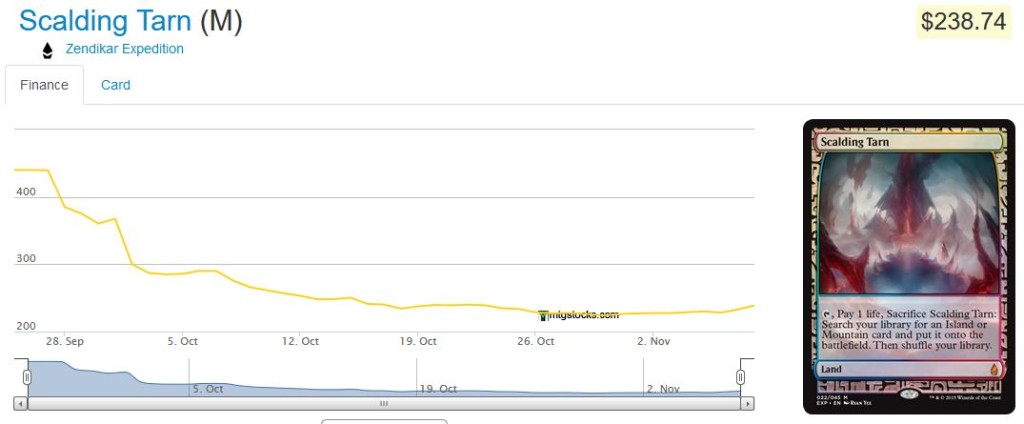
- Leyline of Anticipation recently hit an all-time high. Once near bulk, the enchantment now retails for $6.59 at Star City Games. There aren’t many in stock, and with only the single printing it’s easy to conclude that the older the card becomes, the more value it should gain. Only a reprint would bring downside.
- While I hate buyouts of older cards, I feel obligated to alert everyone to the recent price movement in City in a Bottle. The Arabian Nights rare is nearly sold out all over the internet. Star City Games recently upped their price on the artifact to $69.99, meaning the price movement is likely going to stick. The fact that their sold out tells me the price jumps may not be over on this one, either. This is exactly why I emphasize that if you want any older cards for personal use or collections, think about prioritizing those sooner rather than later. But please don’t speculate on these by buying out the market – it’s unnecessary and leaves a terribly sour taste in the mouths of those who want copies to play with.
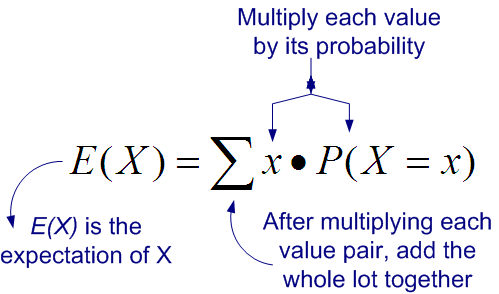
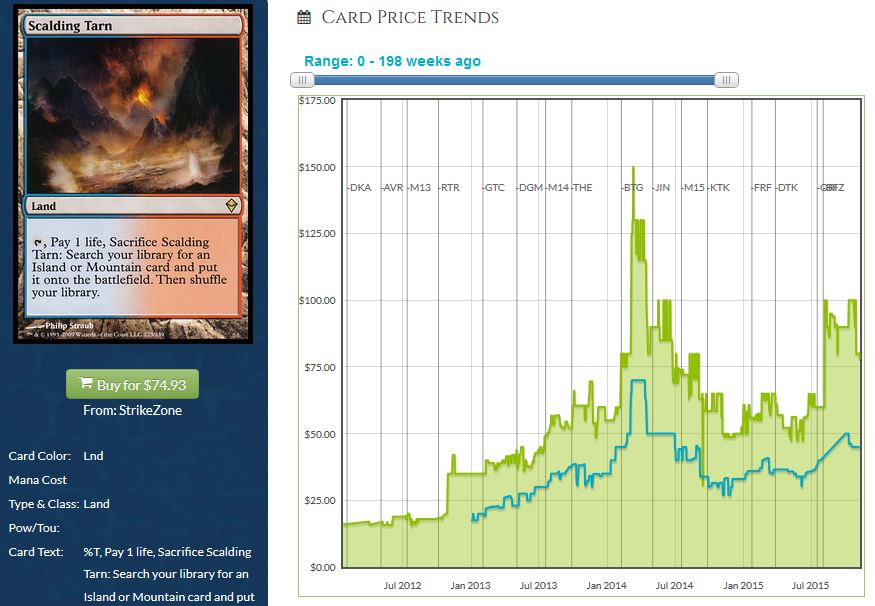

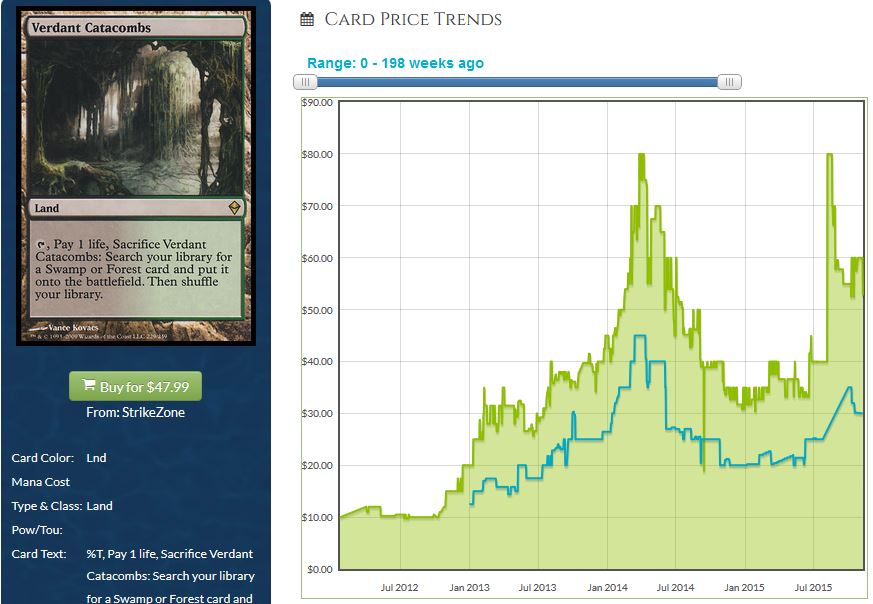
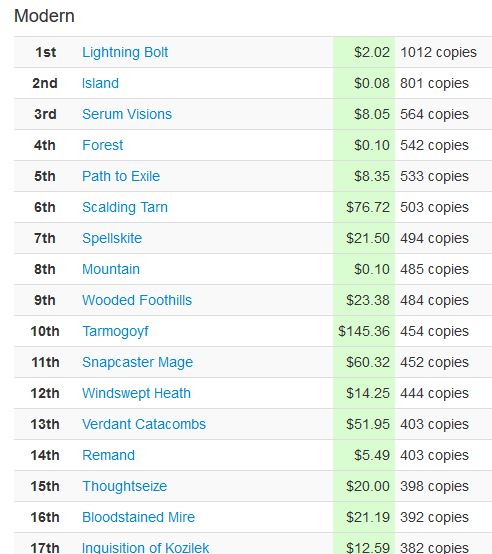
good looks sig — thanks for the article
also appreciate your ongoing 93/94 price movement insights
Thanks for the comment, mct, glad the article read well. I really enjoy getting into technical economics once in a while. It’s fortunate my readers are kind enough to humor me as I look to apply these concepts to MTG Finance. 🙂
Also I’ll try to maintain a balance of alerting folks to Old School cards while not talking about speculation on specific cards. I want everyone to be aware of price movement, but I’m not going to sit here and say “go buy out City in a Bottle because it could spike”. This is a fine line, but I’ve decided to tread it as best I can rather than ignore the trend altogether.
And I just sold 4 catacombs last night on TCG… hope someone on here got ’em and it works out 🙂
I’m leaning more and more towards these won’t get reprinted for a while too.
Snapcaster though… I wonder.
Shucks, I would have bought them! I definitely hope to pick up a few more of these since I feel like they should jump as it becomes more and more obvious that we’re not getting reprints for a while. But there’s always risk involved with this move.
Snapcasters…aren’t they a bit powerful for Standard again? I don’t know if I expect them in Shadows over Innistrad…though now they have an excuse to reprint him with the generic new artwork. :-/
Seems unwise to spend so much on Zen fetches when the prior peak had no substitutes…if you wanted a blue fetch you had to use Tarn or Misty. Now there is a budget alternative in Khans fetches, which are functionally the same in 99% of cases. Hard to justify spending $400 on a play set of Tarns when you can spend $100 on flooded strands, except for the spikiest of spikes.
Jason, you bring up a very fair point. I appreciate the consideration, and I admit I overlooked this factor. That being said, Tarns still spiked to $100 momentarily once it become apparent they weren’t getting reprinted. So I anticipate there’s still upside – What Splinter Twin deck wants to run Flooded Strand instead of Scalding Tarn?
All that being said your point is valid. I’d be more inclined to favor Catacombs even more in light of the oppressively high Tarn price vs. its alternatives.
Sig great article- ive felt like its needed to be spoken about since the big BFZ panic spike happened….because i didnt notice foils jump much, if at all…..
Now we have a situation with expeditions, where the zen set foils are NOT yet obeying the same pricing hierarchy as the onslautht ones: ie set foil as most expensive.
I also havent seen it said this clearly: fetches are THE king of duals. They are superior to the actual duals they fetch, or perhaps “prior” when setting your 60.
Seems to me either expedition enemy fetches are overpriced, or that set foils are under. And with 2 other types of expeditions as reference points (shocks and battle lands), it seems more likely its the set foils being lowballed.
It also seems to me that the battle lands might be an easy win: people WILL use them in modern, maybe the green ones are more likely as green can tutor the basics and leave the fetches for fetchin’ battle duals……turn one Forest–>Wild Cantor–>Caravan Vigil is probably the candyland answer, but you can be hand-droppin Vistas and Glades on turn 2 without issues….
Thanks for commenting! There does seem to be a pricing discrepancy with Expeditions vs. Foils vs. Non-foils. I’m honestly not sure where things will shake out as I haven’t done a ton of research on the foils yet. It may come down to quantities opened of each alongside demand for the different versions, and that will lead to final values for each. In absence of that though, I am not certain which to recommend.
The Expedition Battle Lands do seem relatively affordable, but it will really come down to the kind of demand these see in non-rotating formats. You provided an example, but how much play are these actually seeing outside Standard?
Sig, love the article and your detail as usual…excellent work!
There’s one thing going AGAINST the reprint of the Zendikar fetches in Standard that I didn’t think of until I played this weekend in SCG Philly: STANDARD IS MISERABLE BECAUSE OF ALL THE SLOW FETCHING AND SHUFFLING!! There were so many draws (and players need to learn to concede games and matches to avoid draws) because of all the fetching that the Philly Convention Center seemed to be in a general malaise. NOBODY LIKES TO DRAW AND THERE’S TOO MUCH OF IT IN STANDARD!!!
Now I don’t know if this really influences Wizards, but Wizards claims to want to make players happy and this is a miserable Standard environment. I’ve tried to remain positive, I’ve advocated that even though this is an expensive standard that the decks and fetches are actually good investments, but without playing in a major Star City or GP Standard event (except for States with 100+ people, not 500+) I didn’t realize how painfully miserable it is. This was the sentiment of the majority of players. There’s too many players who shuffle between fetches like it’s the start of the game every time. I was in the draw bracket and faced a Bant Megamorph opponent…I was shocked cause it’s an aggressive deck. I won 1-0 in games and he even told his friends and onlookers I was playing quickly and he slowed us down. It was one of the most painful wins and that was the norm across the room.
So I bring this up because this might contribute to Wizards not reprinting the enemy fetches…
Reason 2 for no reprint is (as mentioned above) to fetch for an Island in Modern a player can simply play $25 Flooded Strands and $30 Polluted Deltas. When I played UR Delver I switched out my Tarns for Deltas and Strands to hide that I was only UR because I never fetched for a mountain. So in Modern there’s 10 fetches available for play and most of the Khans fetches can be substituted for the Zendi fetches in decks…
HOWEVER, Innistrad brought us enemy check lands. I don’t think it’s unreasonable for Wizards to reprint the enemy fetches in Shadows. I don’t know what the lands are supposed to be in Oath, we might not get the Enemy Tango/Battle lands until Shadows (which actually makes a lot of sense for the Standard environment and flavor of enemy colors being favored on Innistrad). Did they announce the Oath lands yet, are we getting enemy tangos??
Lastly, in predicting when the Zendi Fetches get reprinted: if Wizards takes a Modern Masters set off of Tarmogoyf I think the Zendi Fetches would be reprinted to market the set. I wouldn’t mind if in the next MM Innistrad cards like Geist, LotV, Snappy, Olivia, Huntmaster, etc were featured alongside the enemy fetches. Just a fun prediction, I have no idea anymore what Wizards is trying to do, but it seems like a decent idea. Thoughts sir??
Spencer,
Thanks for the kind words and the thorough comment! You touched on many variables I overlooked in my simplified analysis. The slowness of Standard has been touched upon by many dissenters of fetches in the format, and I believe Wizards isn’t ignoring this factor. But they need to balance the trade-off between keeping Modern affordable to appease the masses alongside a fast-paced Standard environment. The two are mutually exclusive.
Additionally, we need to factor in the fact that we have cheaper allied colored fetches, meaning players can be more strategic with where they spend money for their mana bases. But I think the players trying to win large events will fork over the extra cash to play optimal fetches in their lists…not all, but enough.
I can definitely see a fetch land reprint happening in Modern Masters 2017. I’m not so convinced it could happen in Shadows over Innistrad. But this is all my own speculation, of course.
It’s a moving target, of that we can be certain. And that’s why the market is pricing in so much uncertainty. But the more definite we become that no reprint is on the 12 month horizon, the higher these should move in price. We shall see!
Thanks again,
Sig
thanks for your reply Sig. Have a good week
I feel like fetches will be reprinted in Oath or the next block. Why would Wizards bother printing the Battle/Tango fetchable duals if the only way to fetch them rotates out halfway through their life in standard? Are they playable without fetches? In my opinion they’d be worse than the Temples. Would having all 10 fetches in standard for a few months really be that bad? Some decks run 10 or more fetches as is, if the ZEN ones are reprinted, it’s not like decks would run MORE, they’d just change which ones they used. I don’t think it would make the format slower than it already is. I dunno: I think the Battle lands are somewhat telling, but who knows…
Mike,
It’s certainly possible, but I believe you present the minority opinion. Fetches/Battle lands completely warp Standard – it seems like every top deck now plays 4 or more colors with almost no drawback. Decks can basically play whatever cards they want in the format without worrying about a supportive mana base. Adding fetches in a subsequent set like Oath means this will stay with us for many more months to come. Is that what Wizards wants?
That’s the big question.
We shall see!
Because of the predicted spike in modern 2016 would you advise holding on to Tarns until then?